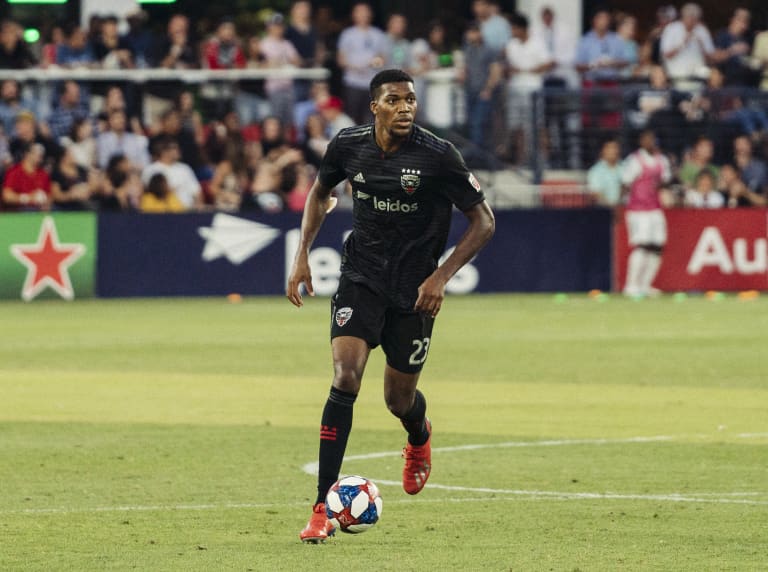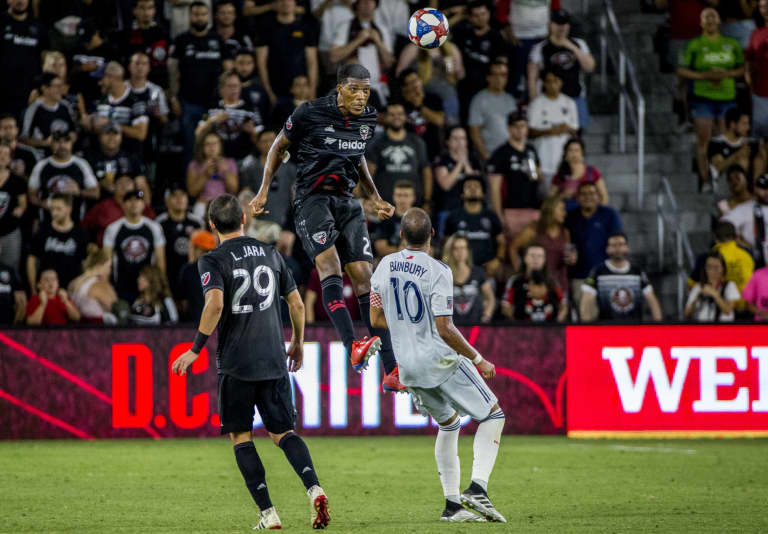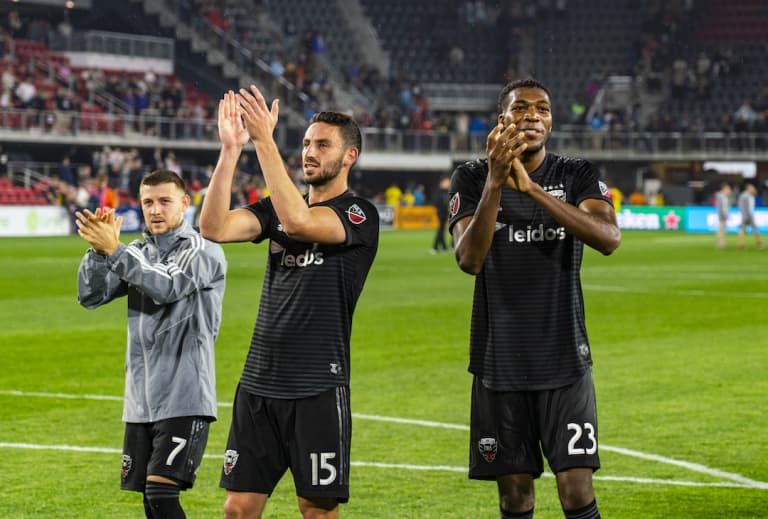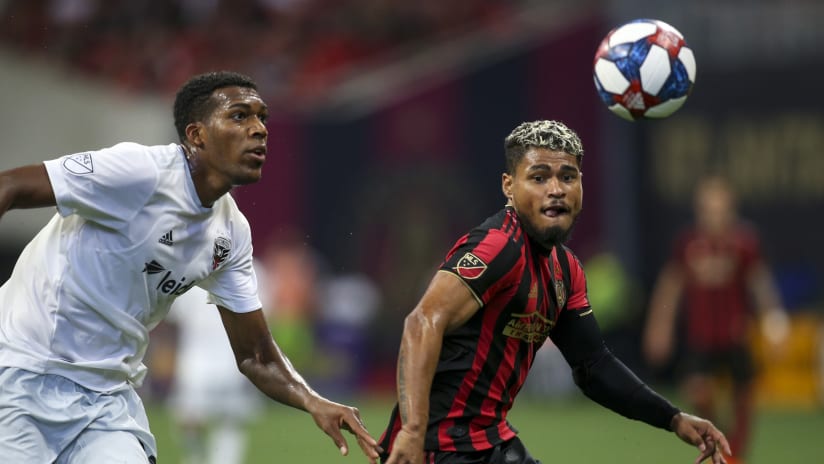Down the hall from a subdued visitor’s locker room at Mercedes-Benz Stadium, where the resilient D.C. United defense had finally succumbed in the 89th minute, coach Ben Olsen shared an embrace with towering center back Donovan Pines.
Pines had performed beautifully in the preceding 88 minutes before an eventual game winner from Gonzalo “Pity” Martinez. He had blasted 10 clearances by himself and twice swiped the ball from the ever-dangerous striker Josef Martinez, who scored 31 goals a year ago and has 16 so far this season, thwarting dangerous attacks inside the box.
But the 21-year-old Pines remains a youthful player for which every match doubles as a learning experience, especially before a raucous crowd of 44,405 on an afternoon when Atlanta United controlled 71.4 percent of possession. For 88 minutes Pines had been terrific as the right-sided player in Olsen’s three-center back alignment, and then a momentary lapse hollowed the undermanned visitors. As Pines drifted toward the near post to defend a potential cross, he encroached on the space occupied by fellow center back Frederic Brillant, and the result was a free header for Gonzalo Martinez at the heart of the 6-yard box.
“As a defender, that’s always the case,” Pines said. “You can play 90 minutes of perfect soccer and then there’s one instant where you lose focus and bam! They just counter. And at this level it happens instantly. I came to understand that it happens to even the best players. I just have to humble myself and be like, OK, you know you can do better but just learn from this, be smarter.”
Which is why Olsen pulled Pines aside to remind his young defender how valuable those moments can be, how crucial those experiences are for a player still five or six years from the prime of his career. “This was a big growth game for you,” Olsen said in the aftermath of a 2-0 defeat. And Pines knew exactly what he meant.
For the third time in as many games, Olsen had employed a line of five defenders featuring Pines, Brillant and Steven Birnbaum as center backs with fullbacks Joseph Mora and Leonardo Jara providing extra width in the attack. In Brillant and Birnbaum, who are the joint league leaders in clearances with 66 apiece, United boasted enough experience to marshal the defense. And in Pines, the budding rookie who signed as a Homegrown Player in January, the coaching staff had a promising ball of clay ready to mold.

At 6 feet 5 inches tall and a shade over 200 pounds, Pines is a mountainous specimen who towers over the majority of attacking players in Major League Soccer — outside of the LA Galaxy’s Zlatan Ibrahimovic. Pines combines supreme aerial ability with above-average pace for a man his size and the result, at least right now, is a prospect relying mostly on raw athleticism while working diligently to sharpen his skills. That the coaching staff trusts him at such a young age — and with so much room to grow — speaks to his potential several years down the line.
“I just want to learn as much as I can because I love learning and understanding the game because I’ve been playing this since I was 5 (years old),” Pines said. “I just try to do the best I can for the team. I was really happy that (Coach Olsen) said this was a good learning experience.”
Yet to suggest that Pines’ three-game run with the starters has been more explorative than effective would be largely incorrect, even as Olsen acknowledged the team’s continued adjustments to their new formation, which resurfaced against the New England Revolution earlier this month. Consider these numbers:
- Pines leads MLS with 4.06 clearances per 90 minutes among players who have logged at least 500 minutes this season. The next-closest player is Colorado Rapids defender Lalas Abubakar at 3.55 clearances per 90 minutes. In fact, there are only five players in the league averaging more than 3 clearances per game, including Brillant at 3.01 per 90 minutes.
- Pines leads United in the following categories among players with at least 500 minutes: interceptions per game; clearances per game; and duels per game. He also ranks second in blocks per game behind defensive midfielder Russell Canouse.
- Among MLS defenders with at least eight appearances, Pines leads the league in total interceptions. He’s also tied for second in total tackles, tied for second in blocks and leads the league in aerial success rate.
- Birnbaum, who is the league’s overall leader in aerial battles won, has a lower aerial success rate (65 percent) than Pines (71 percent), albeit with a much larger sample size.
“I think that’s obviously the strength you have with three center backs is when (opposing teams) get into wide positions, we’re in good shape to defend the cross,” Birnbaum said. “Maybe teams are starting to figure that out and kind of attack us, you know, in different ways. But that’s our strong suit when we have three center backs. And obviously on set pieces it’s good to have three big guys in there. It’s a positive in that sense.”
Predictably, many of Pines’ clearances have come on set pieces during which the coaches afford him the same kind of roaming role he enjoyed at the University of Maryland, where Pines was named second-team All-American as a junior in 2018. A quick glimpse of his college highlight reel shows teammates marking man-to-man defensively while Pines was left free to attack the ball, unencumbered by specific responsibilities. Thus far, United has employed a similar approach by leaving Pines, Birnbaum and Brillant free to attack corner kicks and other set pieces while man marking the opposition with wingbacks, defensive midfielders and their lone striker.
“He towers over most of the guys,” Birnbaum said. “He wins a lot.”

Of course, Pines’ success in aerial duels is due in part to his physical stature, which he says comes mostly from his mother’s side of the family, where his grandfather is 6-4 and two uncles are 6-5 and 6-7, respectively. Pines crossed the 6-foot mark in middle school and approached 6-4 by the time he graduated high school. He dabbled in junior varsity basketball as a way to spend more time with his friends — many of whom, he said, were in awe of his first dunk as a freshman — but quickly dedicated himself to soccer because “I felt like I could dominate in that more.”
His perpetual growth spurt was not without its challenges, though, and Pines said he was constantly adjusting to the length of his arms, legs and torso. Every year, it seemed, he was learning his body anew by exploring the limits of his gangly frame. And while he’s currently listed at 6-5 on the United roster, Pines wonders if he’s closer to 6-6 based on recent comparisons to his uncles.
“I definitely had to work on my timing,” Pines said. “That always had to be a factor. Like, I was always getting taller so I had to get used to my body, my legs and my balance. My center of gravity is high, so I’ve got to make sure I’m grounded and make sure I time it as much as I can. Once I started slowing down and I can figure out my body and understand I should jump at this time when the ball is in the air and just figure out little nuances like that to improve my game, I tried to do that as much as I could when I was younger, and it’s helping me right now.
“I started to figure out I can out-jump everybody and head the ball. And then yeah, it started to become apparent that I’m pretty deadly in the air. Then once I got to college, my coach said, ‘Yeah, you can win headers on the defense, but also you can try to score on headers.’ So each year at Maryland I tried to improve on my heading, offense and defense. Then came my junior year and I started scoring with my head and started being more offensive-minded and more of a threat.”
His development culminated with two goals and two assists in 2018, his final season at Maryland, and the signing of a Homegrown Player contract six weeks later, at which point the learning curve began again. Birnbaum quickly took Pines under his wing by offering tutorials on defensive positioning, the quickest way for Pines to open his hips and insights to fine-tune technique during challenges. They bonded, Pines said, because Birnbaum sees his protégé as someone “he’ll be playing next to in a couple years.”

Just like the start of his college career, when Pines adjusted to Division I soccer, Pines’ acclimation to MLS has superseded the idea of scoring goals with his head, even if his mere presence contributed to striker Quincy Amarikwa’s volleyed goal against the Revolution. Instead, Pines is choosing to polish the skills most applicable to his position along the back line, and he runs through his plan like a checklist: from becoming a sound defender in 1-v-1 situations, to improving his passing, to developing more confidence as a dribbler. (Last week, for instance, Pines remained on the field long after a training session ended to hit diagonal, cross-field passes with assistant coach Chad Ashton, drilling his range and accuracy.)
And so at this point, a little more than halfway through his rookie season, anything Pines contributes on the offensive end is considered a bonus.
“That would be unbelievable,” Pines said of scoring a goal for United, with his first strike disallowed by video assistant referee (VAR) against Minnesota United FC in April.
“Hopefully I don’t cry. It would be something that I would remember my whole life.”
Pines should have plenty of chances, be it this season or in the years to come. Because as Olsen said two weeks ago, after deploying his three-center back lineup at Audi Field, he expects Pines to be “a big part of this club going forward.”





